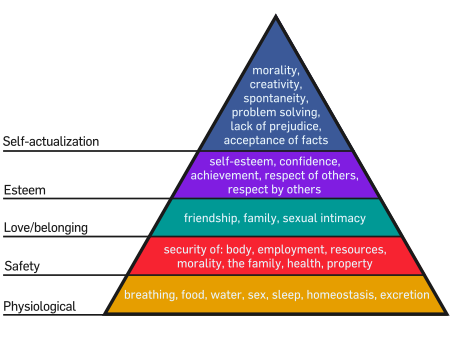Maslow's hierarchy of needs
Maslow's
hierarchy of needs is a
theory in psychology proposed by Abraham Maslow in his 1943 paper
"A Theory of Human Motivation".
Maslow
subsequently extended the idea to include his observations of humans' innate
curiosity. His theories parallel many other theories of human developmental
psychology, some of
which focus on describing the stages of growth in humans.
Maslow used
the terms Physiological, Safety, Belongingness and Love, Esteem,
Self-Actualization and Self-Transcendence needs to describe the pattern that
human motivations generally move through.
Maslow's hierarchy of
needs is often portrayed in the shape of a pyramid with the largest, most
fundamental levels of needs at the bottom and the need for self-actualization at the top. While
the pyramid has become the de facto way to represent the hierarchy, Maslow
himself never used a pyramid to describe these levels in any of his writings on
the subject.
The most fundamental
and basic four layers of the pyramid contain what Maslow called
"deficiency needs" or "d-needs": esteem, friendship and
love, security, and physical needs.
If these
"deficiency needs" are not met – with the exception of the most
fundamental (physiological) need – there may not be a physical indication, but
the individual will feel anxious and tense. Maslow's theory suggests that the
most basic level of needs must be met before the individual will strongly
desire (or focus motivation upon) the secondary or higher level needs.
Maslow also coined
the term Metamotivation to describe the motivation
of people who go beyond the scope of the basic needs and strive for constant
betterment.
The human mind and
brain are complex and have parallel processes running at the same time, thus
many different motivations from various levels of Maslow's hierarchy can occur
at the same time. Maslow spoke clearly about these levels and their
satisfaction in terms such as "relative," "general," and
"primarily."
Instead of stating
that the individual focuses on a certain need at any given time, Maslow stated
that a certain need "dominates" the human organism. Thus Maslow
acknowledged the likelihood that the different levels of motivation could occur
at any time in the human mind, but he focused on identifying the basic types of
motivation and the order in which they should be met.

No comments:
Post a Comment